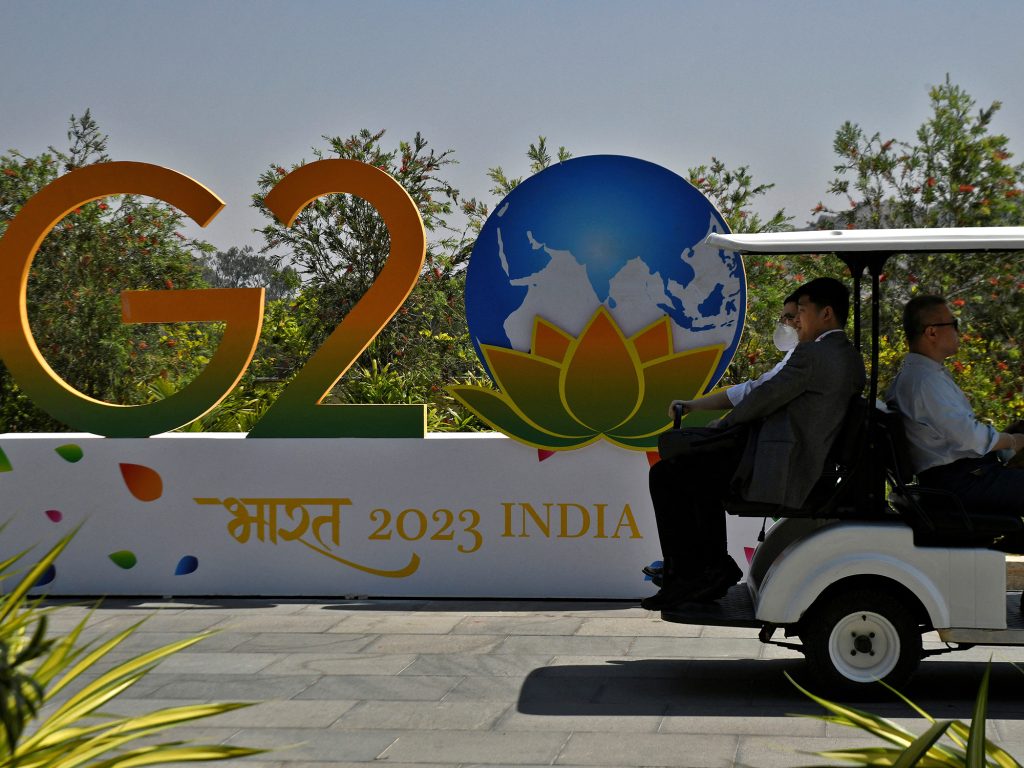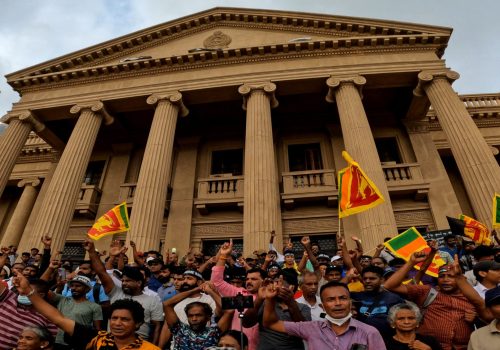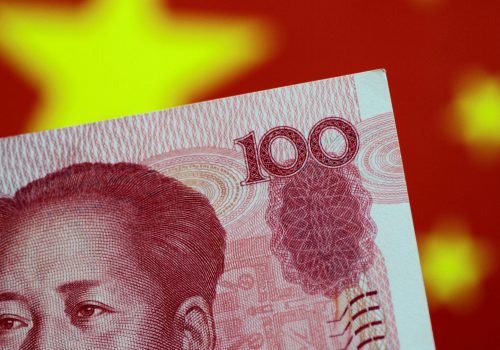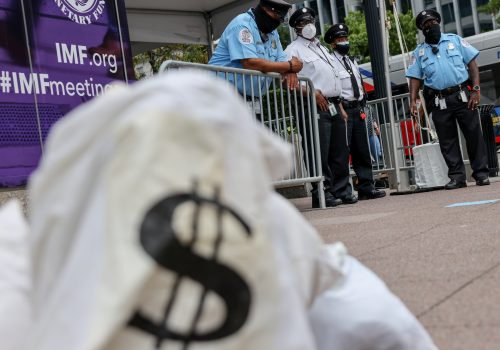It came as a shock last week when India’s Group of Twenty (G20) Sherpa Amitabh Kant—ditching the technical and dense language of economic diplomacy—took on China over the matter of resolving debt in developing countries. “China needs to come out openly and say what their debt is and how to settle it,” Kant declared in response to recent calls from China for the multilateral lenders to write off debt to poor countries. “It can’t be that the International Monetary Fund takes a haircut, and it goes to settle Chinese debt,” he continued. “How is that possible? Everybody has to take a haircut.”
The international community must apply pressure so that China and private-sector lenders join in facilitating a collective haircut that includes all lenders.
As this year’s G20 chair, India clearly wants to position itself as the voice of the Global South, and resolving developing-country debt distress will serve as validation of its approach. The International Monetary Fund (IMF) estimates that 60 percent of low-income countries are in, or at high risk of, debt distress—double the 2015 level. However, the international community has struggled to offer a cohesive solution to resolve the most urgent cases, as the damage from COVID-19 continues to deepen, global growth remains slow, and high inflation continues.
The debt issue will be front and center when G20 finance ministers meet in India this week, with the Indian chair clearly prepared to turn up the heat on recalcitrant creditors. But representatives of the bondholders and some bankers who are major lenders to developing countries were expected to be absent from the discussions as the governments seek to resolve their differences. The meeting, however, can be a hopeful, fresh start.
India’s tongue-lashing of China, coupled with pressure on Beijing from the United States, World Bank, and IMF, brings unprecedented pressure to bear on a single sovereign lender. It is the inevitable result of Beijing’s decision to move at a snail’s pace to resolve the debt crisis that is resulting from its extensive lending—more than eight hundred billion dollars to developing countries between 2000 and 2017. But Chinese flexibility alone will not be enough to resolve the crisis. Comprehensive debt solutions will only become possible when the arm-twisting turns to private-sector creditors (such as powerful asset managers BlackRock and Aberdeen Asset Management and Swiss commodities giant Glencore) whose lending represents a large proportion of several countries’ debt.
Baby steps
To be sure, there have been small steps in that direction. Creditor committees have been established for some of the worst-off debtors—Zambia, Chad, and Ethiopia—with varied results. Committees for Ghana and Sri Lanka are likely to follow suit. But those talks have dragged, offering little hope to nations on the brink of default. The scale and depth of debt issues faced in particular by many African countries require a magnanimous, multilateral approach from all classes of creditors
By some estimates, China’s collection of official and quasi-official lenders accounts for around 13 percent of Africa’s stock of private- and public-sector external debt, much of it made at commercial rates. The private sector, by contrast, accounts for about 40 percent. Multilateral lenders such as the IMF and World Bank, which lend at zero or extremely low interest rates, account for an additional 32 percent. That has led Beijing to call for those institutions to take a haircut as well—a position that lacks support from the rest of the international community, including some borrowers. That’s because multilateral institutions need to retain their preferential status as creditors since they are often the only agencies willing to provide financial assistance during a crisis—when other lenders are unwilling to help. This impasse underlines that there can be no meaningful resolution to developing-country debt distress without the active participation of all lenders.
Of all the failures in global cooperation in recent years, the debt crisis stands out as a sad example of government lenders and private creditors working at cross purposes. At the outset of the pandemic, the G20 appeared to have found a response to the rising cases of debt distress by agreeing to a Common Framework for Debt Treatment (which governs the negotiations in Chad, Ethiopia, and Zambia). Multilateral agencies stepped in to provide emergency loans and some debt relief, and G20 lenders agreed to suspend interest payments until the end of 2021. These actions provided some breathing room for countries at the front line of debt distress and gave creditors the opportunity to organize and resolve the most urgent cases.
But debt resolution in the post-pandemic era has turned into a four-legged stool comprised of national governments, the Paris Club coalition of long-time government lenders and multilateral agencies, China, and private creditors—and if two legs break, the whole stool collapses. That appears to be the case in a world with shifting power dynamics as the Paris Club, led by the Organisation for Economic Co-operation and Development, has found itself out-flanked by more powerful creditors such as China and the private sector. To be sure, the latter two have sharply varying objectives when it comes to debt resolution, and there is no suggestion that they are colluding. While the private sector hopes to extract favorable terms by way of debt repayments or an outright haircut, China’s position is more ambivalent: Geopolitics plays a role, and Beijing prefers having leverage over countries in debt distress. The end result is an international community that cannot deliver.
A study in contrasts
This is starkly evident in the cases of Zambia and Sri Lanka. US Treasury Secretary Janet Yellen met with Chinese Vice Premier Liu He (who is expected to retire soon) in Zurich before she visited Lusaka, Zambia’s capital city, last month to, as she said, “press for all official bilateral and private-sector creditors to meaningfully participate in debt relief for Zambia, especially China.” IMF Managing Director Kristalina Georgieva followed with her own trip to Lusaka, urging a “swift resolution.” Yet there are few overt signs of Chinese flexibility on the six billion dollars it is owed by Zambia. Meanwhile, private holders of Zambian Eurobonds, who account for about 20 percent of Zambia’s external obligations, have largely sat on their hands while the governments try to work out their differences—a stance that hasn’t helped the restructuring process across Africa.
In the case of Sri Lanka, while some major official creditors (India and the Paris Club) have provided financing assurances that are critical to unlocking an IMF loan, China has merely agreed to a two-year moratorium on debt payments, with no indication of any future forbearance. Private-sector creditors—who represent about 40 percent of the country’s outstanding debt—have pursued a more constructive approach, with one group writing to the IMF earlier this month committing to “design and implement restructuring terms.”
Why is the private sector apparently being more cooperative with Sri Lanka than Zambia? In private conversations, bankers say that Sri Lanka has better credit credentials and should be judged as a middle-income country on its capacity and ability to repay in the future. The implied conclusion here is that low-income African countries in debt distress have neither the capacity nor the means to recover from the pandemic-induced shock. If these perceptions are widely held, it is a scathing indictment of the global financial architecture, which incentivized poor countries to reduce aid dependence and encouraged them to access international capital markets to finance their development needs.
What’s next in this never-ending saga of debt and distress? The G20 will try to work out some solutions this week. Two things need to happen to signal to the international community that this year’s G20 will not be business as usual.
First, the G20 has to decide if a new sovereign debt roundtable convened last week by the World Bank and the IMF, which includes China, is a more effective way of addressing debt restructuring cases compared with the Common Framework, which appears to be mired in bureaucratic reporting requirements that have little bite. The private sector’s enthusiasm to participate in the Sri Lanka debt negotiations offers a helpful model for addressing existing and future cases of debt distress, with a focus on a few large individual institutions driving the agenda rather than cumbersome industry associations.
Second, the G20 will have to delicately make a choice regarding China’s role. If the private sector and Paris Club creditors speak with one voice, Beijing may feel isolated enough to come to terms with aligning with the international community.
A new approach is needed, but the G20’s track record of stalemate on difficult issues over the past decade hardly offers confidence. In the absence of a breakthrough, it will be up to the individual governments, led by India, to maintain public pressure. That would likely prove less effective, but Beijing has already shown it will respond to pressure on some debt-related issues—for example, when it agreed to the Common Framework.
The international community needs to build momentum in 2023 for a comprehensive debt resolution. After initially facing the risk of a lost decade of development due to the pandemic, many low-income countries in Africa now face the prospect of several lost decades. To prevent this, the private sector and China need to be shamed into joining forces with the rest of the G20 and do what India has wisely suggested—get a haircut.
Vasuki Shastry, formerly with the IMF, Monetary Authority of Singapore, and Standard Chartered Bank, is the author of Has Asia Lost It? Dynamic Past, Turbulent Future. Follow him on Twitter: @vshastry.
Jeremy Mark is a senior fellow with the Atlantic Council’s Geoeconomics Center. He previously worked for the IMF and the Asian Wall Street Journal. Follow him on Twitter: @JedMark888.
Further reading
Thu, Jul 21, 2022
The world isn’t ready for the looming emerging-market debt crisis
New Atlanticist By
A perfect storm of economic forces threatens to swamp developing countries, and the international community—starting with the G20—isn't prepared to do much about it.
Mon, Dec 13, 2021
China’s real ‘debt trap’ threat
New Atlanticist By Jeremy Mark
Chinese debt relief could help many indebted countries—but failure to act would ensnare both foreign borrowers and Chinese lenders.
Wed, Oct 20, 2021
Let them eat communiqués: Rich countries’ pandemic inaction
New Atlanticist By
Struggling countries came away with more questions than answers from last week's IMF and World Bank meetings.
Image: Delegates ride in a buggy at G20 finance officials meeting venue near Bengaluru, India, February 22, 2023. Photo via REUTERS/Samuel Rajkumar.



